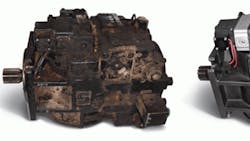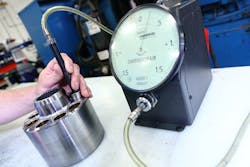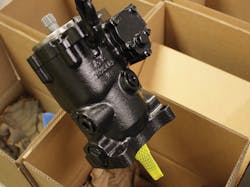Why Risk It with Copycat Hydraulics?
When hydraulic components become damaged or reach the end of their useful lives, off-highway machine users can choose from among many replacement options. An increasing number of solutions are available from original equipment manufacturers (OEMs), independent aftermarket suppliers, and remanufacturers. When searching for the best option to minimize downtime and total cost of ownership, users may consider reverse-engineered products that seem identical to the genuine original versions.
Users expecting quality and performance from replacement products should understand the risk associated with using copycat components, which may not be manufactured and tested to OEM specifications. Before assuming that risk, prospective buyers may want to familiarize themselves with an alternative that continues to gain popularity throughout the off-highway market: remanufactured components from OEMs.
Proven processes
Danfoss Power Solutions specializes in providing components that perform in the harsh operating conditions of the mobile-equipment environment. Pumps, motors, proportional valves, and other hydraulic components are designed, manufactured, and tested to rigorous standards to optimize performance, reliability, and service life. Manufacturers of reverse-engineered solutions typically don’t perform those steps at that level.
This file type includes high-resolution graphics and schematics when applicable.
Danfoss uses only qualified suppliers and works to improve its products using advanced planning tools. One of these tools — the control plan — describes systems for controlling parts and processes. It identifies and documents the part and process controls used to manufacture, assemble, test, paint, handle, and ship as necessary to ensure that the product meets all relevant prints and specifications.
Benefits of developing and implementing a control plan include product quality and customer satisfaction. The control plan reduces waste and improves the quality of products through the design, manufacturing, and assembly stages. It helps identify the sources of variation (input variables) in product characteristics (output variables). The plan also focuses resources on processes and products related to characteristics important to customers, reducing cost without sacrificing quality.
During control-plan development, Danfoss uses all available information, including system, design, and process failure mode and effect analysis (FMEA). FMEAs ensure that, to the extent possible, potential failure modes and associated causes and mechanisms are considered and addressed. Danfoss control plans, FMEAs, material specs, and many manufacturing processes are proprietary information.
Though new or remanufactured reverse-engineered components may appear to be the same as original, they likely haven’t been subject to rigid processes and standards to ensure performance, reliability and durability, like those used by Danfoss. As a result, customers who use copycat new or remanufactured components run the risk of product failure leading to increased downtime and cost — the same issues they try to avoid when poring through replacement options.
Reman on the Rise
Another option — remanufacturing — continues to garner more attention among end users who want original manufacturer’s time- and cost-saving, genuine-quality solutions. In recent years, remanufacturing in the heavy-duty, off-road sector has jumped by more than 50%.
Although the terms are frequently interchanged, “remanufactured” does not mean “repaired.” Danfoss employs remanufacturing processes adapted from the company’s proven OEM manufacturing methods, ensuring that customers receive products meeting or perhaps exceeding original OEM specifications.
Unlike aftermarket suppliers and remanufacturers of reverse-engineered components, Danfoss is a product expert and can rely on their original control plans, FMEAs, material specifications, and qualification testing when remanufacturing products. In addition, Danfoss remanufacturing maintains a connection to the production supply chain, allowing for ready access to new materials and components as necessary.
Rigors of Reman
When a used product (core) arrives at the Danfoss facility, it receives a complete external and internal inspection. The core is disassembled to the component level, identifying worn or damaged parts that need to be remanufactured or replaced. After the remanufactured product is assembled from qualified component stock, it is performance-tested against original Danfoss specifications.
Each remanufactured piston product is fitted with Danfoss Genuine Parts. Consequently, the company can reasonably ensure that the finished product will be of high quality and reliability, as well as offer extended component life and machine uptime, safe equipment operation, and reduced total cost of ownership.
Remanufacturing processes at Danfoss are performed on an industrial scale in a factory setting. Advanced Danfoss remanufacturing procedures include many steps, such as (but not limited to):
- Soda blasting: This single-pass cleaning process for external and internal surfaces uses sodium bicarbonate to remove grease, oil, paint, and other contaminants to return the product back to bare metal.
- Laser micrometer and contact gauge inspection: Danfoss teams take advantage of the same types of tools employed in OEM manufacturing processes to verify all dimensions and clearances.
- Innovative recovery technology: Proprietary technology enables reconditioning of the heart of the unit.
- Coordinate measuring machine (CMM): On-site CMM capability to validate measurements of reconditioned components.
- Expert assembly: Members of the assembly team average 25 years of experience with the company.
- Tool and gauging repair: Capability to produce its own tooling and gauging as well as in-house capability for tooling repair.
- Cleanliness testing: Danfoss checks test stands on a weekly basis to ensure that cleanliness is at specified levels for particle size and content.
- Qualification via test stand: Qualification testing requires that remanufactured products meet original test specifications 100% of the time.
Remanufacturing is not a repair service. Rather, it is a careful sequence of manufacturing processes that results in a quality product.
Rewards of Reman
Customers can manage input costs, lower total ownership costs, and extend machine life by using remanufactured components. When core material is recovered, the price of reman typically runs about 30% less than equivalent new products.
Customers expect short lead times, especially when the need for a product is unforeseen. Danfoss remanufacturing, machining, and assembly operations result in shorter lead times than that of a new product. A distributor or authorized service center typically can provide a factory-remanufactured unit within 24 hours — if not off the shelf — minimizing machine downtime.
Remanufacturing can be beneficial through the entire product life cycle, from component suppliers to manufacturers to consumers, to even the environment. Remanufacturing is a form of recycling that makes optimal use of resources while minimizing waste.
When an off-highway hydraulic machine, for instance, needs replacement components, reverse-engineered products from independent aftermarket suppliers may appear to be ideal. However, such suppliers may not replicate the quality and performance of an original equipment manufacturer’s genuine offerings that endured proven manufacturing processes. Rather than face the risk of component failure associated with copycat products, users may want to seriously consider genuine remanufactured components designed, manufactured, and tested to perform just like new.
BOB NEMETH is Parts & Service Director, Americas for Danfoss Power Solutions. For more information, call (515) 239-6000, or visit parts-service.danfoss.com.




